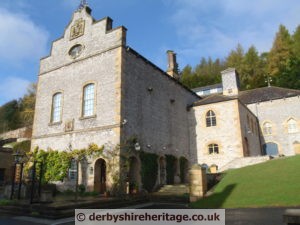Hassop Hall is linked to only five families since the inventory of Domesday Book.
In Domesday HETESOPE is listed as the manor and principal residence of the Foljambes.
This continued until the reign of Richard II(1377-1399) when the eleven month old heiress to Hassop became a ward of the King. He sold her for 50 marks to Sir John Leake, who speedily made one hundred percent profit by re-selling her at a price of 100 marks to Sir William Plumpton, as a wife for his son Thus her dowry of Hassop with a dozen other Lordships and moieties in twenty townships passed to the PLUMPTON family.
By the end of the 15th century, they sold Hassop to Catherine, widow of Stephen Eyre. Since the Eyres were practicing Roman Catholics they had to be very careful when observing their faith as they had to avoid the priest-hunters. They suffered under Elizabeth I but stayed true to their faith.
The Civil War in 1643 brought further troubles for the family when Rowland Eyre (his father had dismantled much of the old Hall and replaced it with the present one) turned Hassop Hall into a Royalist garrison. It was the scene of confrontations with the Parliamentarians and after the Parliamentary victory, the captured property was redeemed at a cost of £21,000. The estate was so rich that this enormous sum of money was raised to retain it.
Francis Eyre, a direct descendant of Stephen, succeeded to the title of Earl of Newburgh in 1814. He had All Saints Catholic church built at the entrance to the Hall 1816-1818. The architect was Joseph Ireland and it was built in the Classical revival style with a Etruscan temple front with five Grecian side windows and Tuscan pilasters at the East end. It has an underground passage to the Hall. Improvements to modernise the Hall and some alterations in the Neo-Classical mould were carried out a few years later. In 1827 – 1833 Thomas Eyre, the seventh Earl of Newburgh modernised the house by moving the entrance from south to West and altering the facade. To the North of the hall is a ballroom raised above the dairy which can be reached via a vaulted passage and stairway. Other subterranean passage, reminiscent of later ones at Welbeck, lead to the lake, church and additional cellar space in the park.
In 1852 the estate passed to Dorothy, sister of Francis, and a year afterwards to her widower, Colonel Charles LESLIE.
The Hall was owned by the Leslies until 1919 when it was bought by Colonel H. K. STEPHENSON (later Sir Henry Stephenson Bt) and eventually became the home of his son Sir Francis Bt until it was purchased by Mr. Thomas H. CHAPMAN, in 1975.



